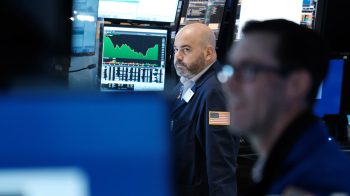Taking Stock: She saw crisis coming
TEXT OF STORY
Two straight months of living in financial crisis mode isn’t really healthy, not if you want to get the bigger picture of how we got into this mess and how we might get out of it. Starting today, we’re going to step back a little bit and have some conversations about the longer view in a series we’re calling “Taking Stock.”
As we look around at the state of the global economy, it’s pretty clear we’ve all been spending way too much money. You and me. Wall Street and governments, too. That spending and the debt that goes with it kind of puts an exclamation point on the financial crisis. Here’s a great example:
The Treasury Department said the budget deficit for October topped $230 billion. That’s the highest monthly total ever and it’s happening because Washington’s starting to pay out all those billions in bailout money.
Economist Ann Pettifor knows a good deal about debt. And she has done something about it, too. She led an successful effort back in the late ’90s to cancel Third World debt. Then she wrote a book called “The Coming First World Debt Crisis.” I asked her how she saw the crisis coming.
Ann Pettifor: I had been working for 10 years on the debt crises of poor countries and middle-income countries, countries like Argentina, and the more I looked at the whole global financial systems and tried to understand why it was that countries had got themselves into this mess, the more I realized that actually the debts of the poorest countries were quite small, relative to the debts of rich countries like my own, Britain, and the United States. The United States and Britain had moved from being the world’s creditors. From 1945 to 1970, we were both effectively creditors to the rest of the world. And then after that, we became the world’s biggest debtors.
Ryssdal: Isn’t it sort of OK for countries that have large economies and great economies of scale to have that debt.
Pettifor: It is, of course, OK to borrow, but it’s not OK to have a global financial system in which there are grave imbalances, where one country will have a big deficit, like the United States and Britain, and other countries, like China will have an enormous surplus. When these get out of synch, they’re likely to just implode.
Ryssdal: What was the mechanism, how did it come to be that the United States and the UK and other Western economies had such great debts?
Pettifor: What happened between 1945 and 1971, we lived within a framework called the Bretton Woods framework, which had been constructed by Roosevelt, President Roosevelt, and John Maynard Keynes and others after the war as a way of preventing the crisis of the 1920s and the ’30s. It ensured that when a country built up a deficit, it was then required to, if you like, structurally adjust its economy, cut back and restore itself to balance. And this happened until the 1970s when the United States began to get itself into deficit, very largely because of the Viet Nam War and began to run out of gold, because Bretton Woods, of course, was anchored in gold. And President DeGaulle of France, for example, was demanding to be paid for his exports in gold.
And so what happened was the economists came to President Nixon and said, “We have a problem here.” And President Nixon said, “Well, why bother to give gold. Why not just offer them dollars and greenbacks.” And they said, “Well, if you did that it would break up the Bretton Woods system.” There had been some strains in the system, then too. And he said, “Well, let’s do that.” With the abandonment of gold, the IMF was charged with finding an alternative to gold. And eventually, they came up with the idea of using U.S. Treasury bills. Now, a Treasury bill is an IOU And, today, poor countries, rich countries all over the world keep these IOU’s in the vaults of their central banks. But what that also meant was the United States was then able to just issue these IOU’s almost without limit and live off that money, that borrowed money.
Ryssdal: And did that give rise, then, to the debt crisis that we’re in now?
Pettifor: What it did was it meant that the United States did not have to structurally adjust its economy and restore it to balance. It was acting, if you like, as the world’s banker. And then at the same time internally and domestically as an economy, the United States was building up individual household and corporate debt. So it was a sort of double-whammy, really.
Ryssdal: One of the things you have done was to organize a massive debt-relief movement. About $100 billion of that was written off by the GA, and yet here we are now eight years later with the International Monetary Fund going around and, at the request of a lot of these countries who are in some trouble, handing out tens of billions of dollars in more debt. Do you think we’re getting ourselves in a situation as we try to get out of this financial crisis where some sort of debt relief might again be needed?
Pettifor: I certainly do. And one of the things I campaigned for very passionately was for a new international framework to deal with the insolvency of countries, a recognition that some countries do go bust. Iceland has gone bust. And if they bust, they must be treated in the way we treat Macy’s or any other company — I remember Macy’s going bust in the ’90s.
Ryssdal: But, it’s one thing, though, wouldn’t you say, for Macy’s to go broke, and it’s another thing for an entire government and a country to go broke.
Pettifor: Well, it isn’t really. We look to the United States, because the United States has got Chapter 11, but it’s also got Chapter 9, which dealt, for example, with Orange County, which is, if I’m not mistaken, a county not far from where you are.
Ryssdal: Ummhmm. Ummhmm.
Pettifor: And dealt also with other municipal crises, with governmental debt. And they are different animals completely. But the point is a civilized society finds a way of resolving and restructuring a debt crisis so as not to destroy the debtor, but to allow it to come back into the economy and play an active part. And I’ve always argued we’ll never going to get an insolvency framework as long as long as its poor countries or small countries like Iceland that needs one. But as soon as a rich country gets into difficulty, and I don’t see that very far off, suddenly, we’ll start talking about a framework.
Ryssdal: Since you saw this debt crisis coming, I wonder if you see a way out. What has to happen?
Pettifor: I say we have to put finance back into its box. We have to say to the bankers, “Thank you, you do us a great service, but your role is to mobilize our savings and to allocate those savings efficiently and appropriately. And we are going to regulate you and we’re not just going to regulate the rate at which you create credit, but we’re also going to regulate the way in which you move money around.”
If government is going to be able to do something about borrowing costs and to manage the crisis, then it’s going to have to do something about capital flows and about the creation of credit. So that’s my answer and I don’t see any other way out of this.
Ryssdal: Ann Pettifor, thank you so much for your time.
Pettifor: Thank you.
Ryssdal: That was Ann Pettifor, she’s a fellow with the New Economics Foundation in London. She’s also the author of a book called, “The Coming First World Debt Crisis.” To hear more from our interview about how governments can deal with global debt check out our Web site, it’s marketplace.org.
There’s a lot happening in the world. Through it all, Marketplace is here for you.
You rely on Marketplace to break down the world’s events and tell you how it affects you in a fact-based, approachable way. We rely on your financial support to keep making that possible.
Your donation today powers the independent journalism that you rely on. For just $5/month, you can help sustain Marketplace so we can keep reporting on the things that matter to you.


















